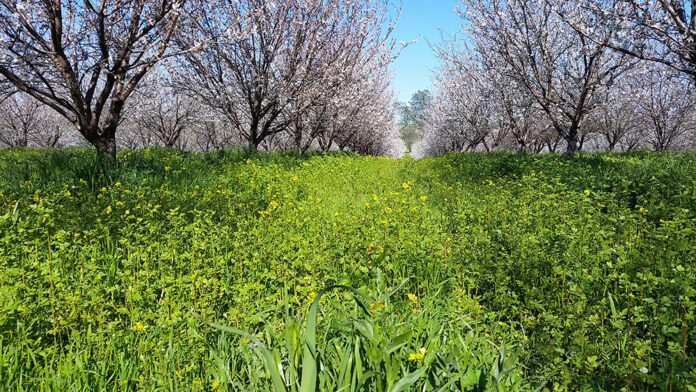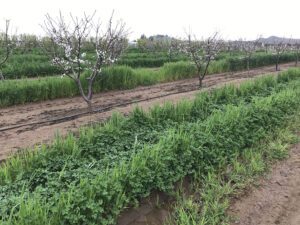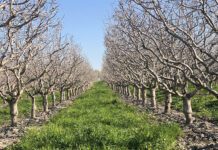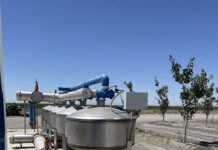
Listen to the audio version of this article. (Generated by A.I.)
As temperatures cool and California’s rainy season begins, plant and microbial activity slows. This reduced biological activity, combined with increased rainfall, leaves many soil nutrients vulnerable to erosion and leaching. Nutrient loss not only impacts soil fertility but also leads to financial losses for growers who must replace these essential elements. Understanding how different nutrients behave in the soil and implementing strategies to retain them can help maintain soil productivity and reduce unnecessary costs.
The leaching potential of nutrients depends largely on their chemical charge. Positively charged nutrients, such as phosphorus, potassium, calcium and magnesium, can bind to negatively charged soil particles like clay and organic matter. This binding helps prevent them from being washed away by water. However, negatively charged nutrients such as nitrate (a common form of nitrogen) do not adhere well to soil particles and are highly susceptible to leaching.
Erosion, on the other hand, has greater effects on nutrients bound to soil particles. When topsoil is lost due to wind or water movement, the nutrients attached to it, particularly P, are carried away. P pollution in waterways is a significant environmental concern and much of it originates from eroded soil rather than leaching alone.
Growers face a double financial burden when nutrients are lost: first, in the form of reduced soil fertility, which can lower crop yields and second, in the cost of replacing those nutrients through fertilizers. Preventing nutrient loss is often more cost-effective than replenishing lost nutrients, making winter nutrient retention strategies essential for long-term farm profitability.
Cover Crops Help Retain Nutrients
One of the most effective ways to retain soil nutrients during the winter is by planting cover crops. Cover crops absorb available nutrients from the soil, preventing them from leaching away with rainwater.
In addition, cover crops can reduce the impact of rain and wind by covering the soil surface and developing extensive root systems. This reduces the amount of topsoil lost to erosion and thereby limits the nutrients lost in this manner.
Cover crops can also contribute to soil nutrients through N fixation. Leguminous cover crops like the Seeds for Bees Nitrobuilder mix form symbiotic relationships with N-fixing bacteria. These bacteria convert atmospheric N into a plant-available form.
When cover crops are terminated in the spring, the nutrients stored in their biomass are released back into the soil as they decompose. While the exact nutrient content of cover crops varies by species and growing conditions, general estimates can provide insight into their nutrient retention potential:
• Nitrogen (N): can range from 1% to 7% of dry biomass though usually 4% or less (legumes typically range at 4% while non-legumes range closer to 3%.)
• Phosphorus (P): approximately 0.05% to 0.5% of dry biomass
• Potassium (K): 2% to 3% of dry biomass (some species may contain up to 10%.)
These values are not precise enough for calculating exact nutrient contributions but demonstrate the ability of cover crops to retain and recycle nutrients. For accurate measurements, growers should send biomass samples to a lab for analysis.

Factors That Affect Decomposition
There are several factors which affect nutrient release and the rate of biomass decomposition. The main factors controlling the speed of decay are available moisture, temperature and microbial activity. Dry conditions greatly slow decomposition, making water vital for this process. In areas with wetter climates or full-coverage irrigation, early termination is not as critical and cover crops can be allowed to grow longer in the season.
When factoring nutrients from a cover crop, growers should take soil samples shortly after cover crop decomposition to assess nutrient levels before factoring them into fertilizer plans.
Additional Benefits of Cover Crops
Beyond nutrient retention, cover crops provide several additional advantages such as increasing soil organic matter, supporting microbial communities, suppressing weeds and improved water infiltration.
Organic matter improves soil structure, water retention and nutrient-holding capacity. As cover crops decompose, they contribute to organic matter buildup, enhancing long-term soil fertility.
Soil microbes play a crucial role in nutrient cycling, organic matter breakdown and symbiotic relationships with plant roots. Bare soils lack the root exudates and plant interactions necessary to sustain microbial life. Cover crops maintain these microbial populations through the winter, ensuring a biologically active soil ecosystem.
Dense cover crop stands can outcompete weeds, potentially reducing the need for herbicides. Some species like brassicas also release allelopathic compounds that can inhibit small-seeded weed germination.
‘Preventing nutrient loss is often more cost-effective than replenishing lost nutrients, making winter nutrient retention strategies essential for long-term farm profitability.’
Cover crop roots create channels in the soil, improving water infiltration and reducing runoff. This is particularly beneficial in regions with heavy winter rains and is another way cover crops can reduce erosion.
Growers in California interested in adopting cover crops can take advantage of programs like Seeds for Bees, offered by Project Apis m. This program provides free cover crop seeds to support pollinator habitats and soil health. First-year participants can receive up to $2,500 in free seed while second-year participants are eligible for up to $1,500 in free seed. Applications are accepted from April 1 to August 31 each year.
While cover crops are highly effective, other methods can also help retain winter nutrients such as mulching, reduced tillage and strategic fertilizer application.
Applying organic mulch (straw, wood chips or compost) protects the soil from erosion, reduces leaching and slowly releases nutrients as it breaks down.
Minimizing soil disturbance preserves soil structure, reduces erosion and maintains microbial habitats. No-till or reduced-till systems are particularly effective in combination with cover crops.
Though winter can pose as the greatest period of nutrient loss, nutrients can be lost anytime throughout the year. Being aware of the cation exchange capacity (the capacity of the soil to retain cations or positively charged nutrients) and the water infiltration rate of the soil can reduce the risk of overapplying fertilizer or washing nutrients past the root zone. This can be of particular importance for fertigation applications in sandy soils.
Winter poses a significant challenge for nutrient retention in Californian agricultural soils, but proactive strategies can mitigate losses. Cover crops stand out as an effective solution, offering nutrient sequestration, erosion control and long-term soil health benefits. Programs like Seeds for Bees provide valuable support for growers looking to adopt these practices, making it easier to transition to more nutrient-efficient systems.
The application for Seeds for Bees can be accessed on the Project Apis m. webpage and takes an average of five minutes to complete. The program is entirely funded by donations, making the opportunity stackable with any state or federal grant.















